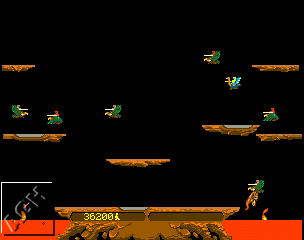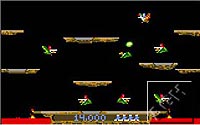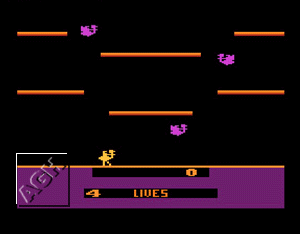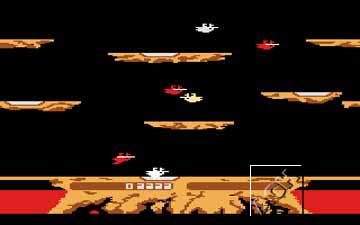|
- CROSS-PLATFORM REVIEW: JOUST (2600/5200/7800) -
by Maurice Molyneaux

Arcade Joust
Like many popular arcade games of the early 80's, Williams' Joust
was ported to just about every Atari system. This review concerns
the 2600, 5200 and 7800 versions.
Several users have suggested adding the Lynx version to this
comparison, and I intend to do so as soon as I can get my hands on it.
I order to write this review I set up all three systems and played
the games back to back. For comparison, I then played the original
arcade game--via emulation on the Sony Playstation.
For those of you who, for whatever reason, never played Joust, the
game is fairly simple. One or two players take control of knights
riding upon flying ostriches, and engage enemy knights riding huge
buzzards. The joystick moves your mount left and right, and the
fire button causes the mount to "flap", which controls altitude.
"Jousting" occurs whenever two opposing riders collide. Players
can dismount one another, so rounds can be played competitively or
cooperatively. The computer controlled enemies do not kill each
other when they collide, rather, they simply change direction.
Which of two opponents "wins" in a collision is determined not by
where a lance lands, but simply by whose lance is higher. Lances at
equal height are a draw. Thus, it is possible to win a joust by
colliding your bird's butt with an enemy's lance! Therefore, the
most common tactic is to "belly flop" atop an opponent to destroy
him.

Lynx Joust
Enemies initially appear on one of several materialization
points. Likewise, when a player is killed, his next life (if any)
materializes on one of these materialization points.
When an enemy has been defeated in a joust, he does not simply vanish.
Left in his wake is an egg, which--if the player doesn't scoop it up
within a short time--quickly hatches into a new enemy knight of a higher
rank than the one defeated. The enemy knights come in three flavors,
each one more dangerous than the last: Bounders (red), Hunters (gray),
and Shadow Lords (blue).
The screen is mostly open space, but for a series of floating stone
platforms, which aid you in evading enemies and setting up ambushes.
The platform arrangement changes as the game progresses, leaving
varying amounts of space for maneuvering and evading.
In addition to being dismounted by other riders, there are three
other dangers. First, after the first few rounds, lava pits open
to either side of the bottom platform, so landings must be carefully
considered, or it's Kentucky Fried Ostrich time. Flying low over
the lava reveals yet another danger, the Lava Troll: a disembodied
hand which tries to seize low-flying birds and drag them into the
lava. Fortunately, the Troll will grab any knight's bird, player
or enemy. The final danger is from the Pterodactyl, which appears
if a round goes on too long. The Pterodactyl actively hunts down
the players, and the only way to destroy it is to lance it in the
mouth (very difficult to do).
That's Joust in general, now to the specifics of the individual
conversions.

2600 Joust
Playing the 2600, 5200 and 7800 versions of Joust one after another
points out just how different each is. Play details between the
three vary a great deal, with the 2600 being least like the arcade
model and the 7800 being the truest, as you'd expect.
The playfields on the 5200 and 7800 are fairly authentic, with the
various platforms appearing where they should. The 2600 version is
another matter, with a playfield that is perfectly symmetrical
left-right, is absent two the "stepped" platforms on the other
versions, and which features spaces between the platforms which are
proportionally too small, making it tougher to maneuver between
them when they are all present.
The handling of the rebirths of the enemy buzzard riders differs on
all three versions. In the arcade, when an enemy is dismounted, an
egg appears and arcs across the screen, falling to earth if the
player does not catch it or it does not plunge into the lava. If
an egg is left alone long enough, it hatches and a new rider
appears. After a few moments, a buzzard will fly in and pick him
up, making a new threat if the player doesn't quickly scoop up the
new rider. The 7800 version faithfully reproduces this (although
it adds some overdone sound effects for the egg hatching), whereas
on the 5200 the eggs hatch into riders already atop buzzards,
and the player has until the eggshell vanishes to pick up the new
hatching, otherwise it becomes airborne. The 2600 takes this
simplification one (albeit weird) step further: eggs do not fall,
they fly, as if on wings! They lazily cruise through the sky,
and when they hatch, an already airborne rider and buzzard
appear. It is understandable that the 2600's limitations would
result in some changes, but this particular choice is just plain
odd, particularly given that a routine for calculating the "fall"
of an object is in the game (just stop flapping and you'll see it
in action). The 5200's elimination of the buzzards flying in to
pick up the new riders smacks of a programmer who didn't want to
bother with getting all the details right, or was overwhelmed by
the number of moving objects this would involve.
The Pterodactyl in the 7800 and 5200 versions behaves pretty much
as it does in the arcade, while on the 2600 it does not seem as
"smart" and doesn't actively track the player. To make up for
this the programmer chose to have it reappear at a different and
more threatening altitude each time it leaves the screen, instead
of having the it "wrap" around as it does in the other versions.

5200 Joust
Graphically, the games are as far apart as you'd expect. The 2600
version looks more like a graph-paper sketch of a Joust screen
than anything else. The 5200 and 7800 versions are much closer,
rendering the platforms as rocky shapes. On the 2600 the birds
and riders are single color objects. On the 5200 they are single
color but for their lances, which stand out in white. Pterry's
and the Lava Troll hand are likewise single color on both of those
versions. The 7800 improves on this, with multi-color
characters which are much more attractive. The 7800 also
reproduces such nice details as the flames which "burn" away
the covers from the lava pits.
Finally, there's game play. What's most striking about all three
versions is how different they "feel". The physics in each are
distinct. The same flap rates do not produce similar results
across the versions, and the physics of "falling" are likewise
different. In all three versions, gaining altitude is much easier
than it is in the arcade, and, thus, holding a steady altitude
is somewhat tougher.
The original Joust was a breakthrough game at the time of its
release, and, unlike many of its brethren of the same era,
remains as much fun to play today as then. The various Atari
versions, however, haven't all aged quite as gracefully. Having
seen what a good programmer can do on the 2600, it's tough to
accept the oddball abridgments made to that version, and the
weird playfield design and relatively large characters makes
the game less fun to play than it should have been. The 5200
and 7800 versions are a lot better, and, overall, the 7800 is
the best of the lot, in both terms of look and play...just as
you'd expect (although the 5200's "flap" rate feels a bit
closer to the arcade). However, as much fun as it was to do
this little comparison, I'll stick to the arcade original...
thank goodness for emulation!
Copyright 1997 by Maurice Molyneaux.
Authorized for publication on AGH, this article may not be
posted to other web-sites or printed without express
permission of the author.
|




